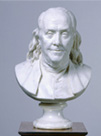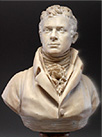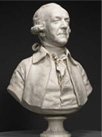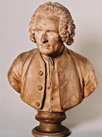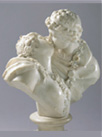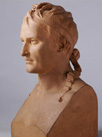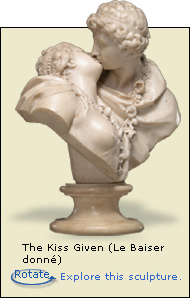| Education | ||
| Exhibitions | ||
| Explore Art | ||
| Research and Conservation | ||
| Bookstore | ||
| Games | ||
| About the J. Paul Getty Museum | ||
| Public Programs | ||
Press Kit |
||
| Museum Home
|
November 4, 2003–January 25, 2004 at the Getty Center
The following is a selection from the 70 sculptures by Houdon included in the exhibition.
Houdon and America
During the American Revolutionary War era, Houdon sculpted many prominent heroes of the fledgling republic. His statue of George Washington stands in the capitol building in Richmond, Virginia—a commission awarded at the recommendation of his friends Benjamin Franklin and Thomas Jefferson. Houdon's portrait of Jefferson was chosen in 1938 for the American nickel, still in circulation today.
Benjamin Franklin (1706–1790) was a printer, writer, scientist, and statesman. His famous kite experiment, which demonstrated that lightning is an electrical discharge, brought him international acclaim. As a statesman, Franklin held a seat in the Pennsylvania Assembly. In 1776, he won financial aid from France for the American Revolution. He helped negotiate the peace treaty with Great Britain, signed in Paris in 1783. |
Robert Fulton (1765–1815) was an American engineer, inventor, and artist. With Robert R. Livingston, Fulton developed the first commercially successful steamboat in America. |
Houdon and the European Courts
Houdon held the title of sculpteur du roi (sculptor to the king) during the reign of Louis XVI. Although he received very few French royal commissions, Houdon's fame spread throughout Europe through enthusiastic recommendations of Enlightenment thinkers and visits made to his Paris studio by traveling aristocrats, diplomats, and royalty who commissioned their portraits from him.
Louis XVI (1754–1793) was king of France from 1774 to 1793. He married Marie-Antoinette, daughter of the Hapsburg empress Maria Theresa. France was in financial trouble and Louis's involvement with the American War of Independence exacerbated the national debt. In 1789 he was taken hostage by the French revolutionary movement. In 1792, insurrectionists abolished the monarchy and the king was guillotined in January 1793. |
Houdon and the Enlightenment
A gifted artist who was sympathetic to the ideas of his time, Houdon became the preferred sculptor of leaders and artists of the Enlightenment. Influential thinkers such as Denis Diderot and Voltaire promoted the work of the young artist, greatly expanding the reach of Houdon's career.
Jean-Jacques Rousseau (1712–1778) was a French philosopher, writer, and political theorist of the Enlightenment. His philosophy marked the end of the Age of Reason and the onset of the French Revolution. He endorsed a return to nature, virtue, a renewed interest in children, and the universal right to liberty and happiness. |
Portraits of Children
Houdon's many portraits of children were very popular. He was lauded for the innovative manner in which he captured the innoncence and liveliness of childhood.
Alexandre Brongniart (1770–1847) grew up to be a French naturalist and geologist who coined the term jurassic. He became professor at the Sorbonne and Museum of Natural History, and director of the porcelain manufactory at Sèvres. |
Myths and Allegories
From the time of the Renaissance, French palaces and gardens were traditionally adorned with sculptures of mythological and allegorical figures, the best-known example being the palace and park of Versailles. In the mid-18th century, a vogue to redesign gardens, complete with fountains, follies, and sculpture created an increased demand for indoor and outdoor sculpture. These trends benefited Houdon immensely.
Many enlightened patrons appreciated Houdon's sensual sculpture, adorning their palaces and gardens with his works, including The Kiss Given (Le Baiser donné), the equally erotic bronze Winter, and bronze sculptures of Diana and Apollo, which are reunited in this exhibition for the first time since 1796. |
||||||||
After the Revolution
Houdon adapted to the demands of rapidly changing political and social trends. By the end of the French Revolution, his commissions waned, yet the entrepreneurial sculptor remained active until the end of Napoléon's reign. Despite declining prospects and increasing criticism, Houdon produced for the Empire some of the masterpieces of Neoclassicism. In his late portraits, Houdon embraced the current idealism and revival of antiquity while maintaining the character and essence of his sitters.
Napoléon Bonaparte (1769–1821), self-declared emperor of France, rose to power with successful military campaigns against the French monarchy and France's neighbors, which expanded the French Empire to include France, Belgium, Holland, Croatia, Dalmatia, and parts of Italy. Napoléon's invasion of Russia, however, was disastrous, and he was forced to abdicate. In 1815 he was exiled to the island of Saint Helena off the coast of Africa. |
